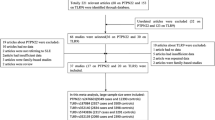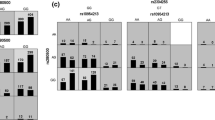Abstract
Systemic lupus erythematosus (SLE) is a multifactorial autoimmune disease. Although genetic factors confer susceptibility to the disease, only 15 % of the genetic contribution has been identified. TRAF3IP2 gene, associated with susceptibility to psoriatic arthritis and psoriasis, encodes for Act1, a negative regulator of adaptive immunity and a positive signaling adaptor in IL-17-mediated immune responses. The aim of this study was to assess the role of TRAF3IP2 gene variability in SLE susceptibility and disease phenotype in an Italian population. Two hundred thirty-nine consecutive SLE patients were enrolled. Study protocol included complete physical examination; the clinical and laboratory data were collected. Two hundred seventy-eight age- and ethnicity-matched healthy subjects served as controls. TRAF3IP2 polymorphisms (rs33980500, rs13190932, and rs13193677) were analyzed in both cases and controls. Genotype analysis was performed by allelic discrimination assays. A case–control association study and a genotype–phenotype correlation were performed. The rs33980500 and rs13193677 resulted significantly associated with SLE susceptibility (P = 0.021, odds ratio (OR) = 1.71, and P = 0.046, OR = 1.73, respectively). All three TRAF3IP2 single nucleotide polymorphisms resulted associated with the development of pericarditis; in particular, rs33980500 showed the strongest association (P = 0.002, OR 2.59). This association was further highlighted by binary logistic regression analysis. In conclusion, our data show for the first time the contribution of TRAF3IP2 genetic variability in SLE susceptibility, providing further suggestions that common variation in genes that function in the adaptive and innate arms of the immune system are important in establishing SLE risk. Our study also shows that this gene may affect disease phenotype and, particularly, the occurrence of pericarditis.
Similar content being viewed by others
References
Cárdenas-Roldán J, Rojas-Villarraga A, Anaya JM (2013) How do autoimmune diseases cluster in families? A systematic review and meta-analysis. BMC Med 11:73
Cervera R, Abarca-Costalago M, Abramovicz D et al (2006) European Working Party on Systemic Lupus Erythematosus. Systemic lupus erythematosus in Europe at the change of the millennium: lessons from the “Euro-Lupus Project”. Autoimmun Rev 5:180–6
Ciccacci C, Biancone L, Di Fusco D et al (2013) TRAF3IP2 Gene is associated with cutaneous extraintestinal manifestations in inflammatory bowel disease. J Crohns Colitis 7:44–52
Crow MK (2008) Collaboration, genetic associations, and lupus erythematosus. N Engl J Med 358:956–61
D’Cruz DP, Khamashta MA, Hughes GR (2007) Systemic lupus erythematosus. Lancet 369:587–96
Excoffier L, Lischer HE (2010) Arlequin suite ver 3.5: a new series of programs to perform population genetics analyses under Linux and Windows. Mol Ecol Resour 10(3):564–7
Gateva V, Sandling JK, Hom G et al (2009) A large-scale replication study identifies TNIP1, PRDM1, JAZF1, UHRF1BP1 and IL10 as risk loci for systemic lupus erythematosus. Nat Genet 41:1228–33
Gatto M, Zen M, Ghirardello A, Bettio S, Bassi N, Iaccarino L, Punzi L, Doria A (2013) Emerging and critical issues in the pathogenesis of lupus. Autoimmun Rev 12:523–36
Genetic Analysis of Psoriasis Consortium & the Wellcome Trust Case Control Consortium 2, Strange A, Capon F et al (2010) A genome-wide association study identifies new psoriasis susceptibility loci and an interaction between HLA-C and ERAP1. Nat Genet 42:985–90
Giltiay NV, Lu Y, Allman D, Jørgensen TN, Li X (2010) The adaptor molecule Act1 regulates BAFF responsiveness and self-reactive B cell selection during transitional B cell maturation. J Immunol 185:99–109
Hochberg MC (1997) Updating the American College of Rheumatology revised criteria for the classification of systemic lupus erythematosus. Arthritis Rheum 40:1725
Hoffman IE, Peene I, Meheus L et al (2004) Specific antinuclear antibodies are associated with clinical features in systemic lupus erythematosus. Ann Rheum Dis 63:1155–8
Hüffmeier U, Uebe S, Ekici AB et al (2010) Common variants at TRAF3IP2 are associated with susceptibility to psoriatic arthritis and psoriasis. Nat Genet 42:996–9
Hunter CA (2007) Act1-ivating IL-17 inflammation. Nat Immunol 8:232–4
International Consortium for Systemic Lupus Erythematosus Genetics (SLEGEN), Harley JB, Alarcón-Riquelme ME et al (2008) Genome-wide association scan in women with systemic lupus erythematosus identifies susceptibility variants in ITGAM, PXK, KIAA1542 and other loci. Nat Genet 40:204–10
Li X (2008) Act1 modulates autoimmunity through its dual functions in CD40L/BAFF and IL-17 signaling. Cytokine 41:105–13
Liu C, Qian W, Qian Y et al (2009) Act1, a U-box E3 ubiquitin ligase for IL-17 signaling. Sci Signal 2:ra63
Maddur MS, Miossec P, Kaveri SV, Bayry J (2012) Th17 cells: biology, pathogenesis of autoimmune and inflammatory diseases, and therapeutic strategies. Am J Pathol 181:8–18
May MJ (2011) IL-17R signaling: new players get in on the Act1. Nat Immunol 12:813–5
Miyakis S, Lockshin MD, Atsumi T et al (2006) International consensus statement on an update of the classification criteria for definite antiphospholipid syndrome (APS). J Thromb Haemost 4:295–306
Musone SL, Taylor KE, Nititham J et al (2011) Sequencing of TNFAIP3 and association of variants with multiple autoimmune diseases. Genes Immun 12:176–82
Namjou B, Choi CB, Harley IT et al (2012) Evaluation of TRAF6 in a large multiancestral lupus cohort. Arthritis Rheum 64:1960–9
Perricone C, Ceccarelli F, Valesini G (2011) An overview on the genetic of rheumatoid arthritis: a never-ending story. Autoimmun Rev 10:599–608
Pisitkun P, Claudio E, Ren N, Wang H, Siebenlist U (2010) The adaptor protein CIKS/ACT1 is necessary for collagen-induced arthritis, and it contributes to the production of collagen-specific antibody. Arthritis Rheum 62:3334–44
Qian Y, Giltiay N, Xiao J et al (2008) Deficiency of Act1, a critical modulator of B cell function, leads to development of Sjögren’s syndrome. Eur J Immunol 38:2219–28
Rodgers JM, Zhou L, Miller SD (2010) Act1, scene brain: astrocytes play a lead role. Immunity 32:302–4
Ruiz-Irastorza G, Khamashta MA, Castellino G, Hughes GR (2001) Systemic lupus erythematosus. Lancet 357:1027–32
Selmi C, Leung PS, Sherr DH, Diaz M, Nyland JF, Monestier M, Rose NR, Gershwin ME (2012) Mechanisms of environmental influence on human autoimmunity: a National Institute of Environmental Health Sciences expert panel workshop. J Autoimmun 39:272–84
Shapira Y, Agmon-Levin N, Shoenfeld Y (2010) Geoepidemiology of autoimmune rheumatic diseases. Nat Rev Rheumatol 6:468–76
Tsokos GC (2011) Systemic lupus erythematosus. N Engl J Med 365:110–21
Conflict of interest
The authors have no conflict of interest to declare.
Author information
Authors and Affiliations
Corresponding author
Additional information
CP and CC contributed equally to this work
Rights and permissions
About this article
Cite this article
Perricone, C., Ciccacci, C., Ceccarelli, F. et al. TRAF3IP2 gene and systemic lupus erythematosus: association with disease susceptibility and pericarditis development. Immunogenetics 65, 703–709 (2013). https://doi.org/10.1007/s00251-013-0717-6
Received:
Accepted:
Published:
Issue Date:
DOI: https://doi.org/10.1007/s00251-013-0717-6




